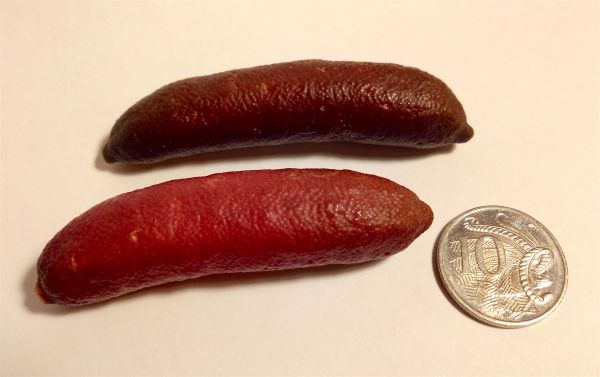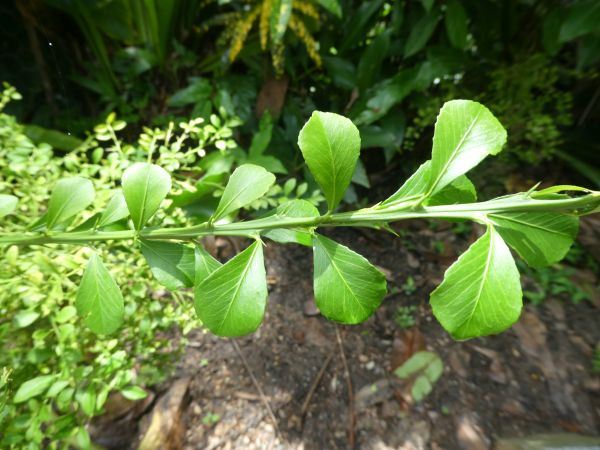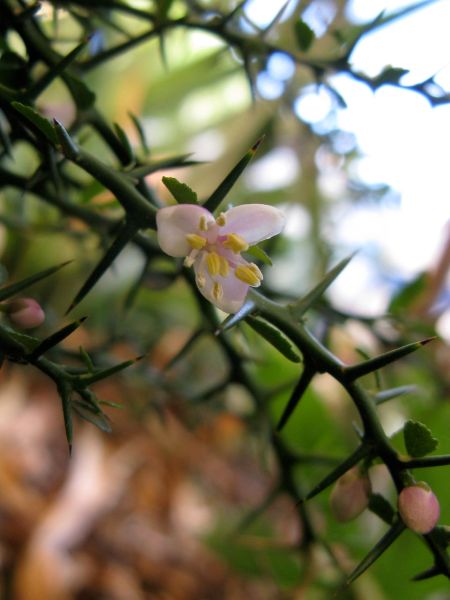
Your Backyard Fruit Bowl – Finger Limes
Red finger lime flesh - Photo by Ivar the Boneful via commons.wikimedia.org CC BY-SA 4.0
Finger limes: a short family history
Suitable climates and growing conditions
Native Australian finger limes made a big splash in the culinary and plant-collecting communities a few years back – and with good reason. With novel fruit shapes and colours, and thin skins bursting with juicy vesicles which lend a jewelled, caviar-like quality to their flesh, finger limes are a true connoisseur’s fruit. Now that the initial hype has waned a bit, the price tag for a single plant is a bit more amenable to the everyday home gardener too.
Known as gulalung and long valued by Aboriginal communities as a reliable and nutritious traditional food source, finger limes and other related indigenous Australian citrus, of which there are six species in total, have gained much recognition since the 1970s, along with many other types of bushfood from lemon myrtle to kangaroo meat. With increased popularity has come commercial cultivation of these indigenous food crops, several of which are now widely available for purchase, commonplace on restaurant menus, and even exported as gourmet essentials.
If you live in a climate conducive to growing other types of citrus, are looking for something novel but tasty (and don’t mind a few thorns), give finger limes a whirl.
Finger limes: a short family history

Red finger lime fruit - Photo by Ivar the Boneful via commons.wikimedia.org CC BY-SA 4.0
Australian finger limes, Citrus australasica are native to Australia’s east coast, in a region stretching from southeastern Queensland to northeastern New South Wales.
Not to be outdone taxonomically by other members of the genetically-diverse Citrus genus, C. australasica was initially described in 1858 by botanist Ferdinand von Mueller. An American botanist, Walter Tennyson Swingle then revised the genus in 1915, placing the Australian species in two new genera, Microcitrus and Eremocitrus, based on the observation that the indigenous plants’ morphological features lent them “a very different aspect from the commonly cultivated species of Citrus.” This classification stood until 1998, when British botanist David Mabberley examined the subtribe Citrineae (of which Microcitrus, Eremocitrus and other genera such as Poncirius – bearer of common citrus rootstocks such as Trifoliata belong to) and put forward the case that due to their wide-ranging morphological features and ability to cross with each other, the finger limes should be restored to the genus Citrus. So, they were! As a legacy, you may still see some finger limes referred to by the synonym Microcitrus australasica.
If you’re new to growing fruit, this orchard overview covers the basics and how to get started.
Suitable climates and growing conditions

Citrus australasica-small tree - Photo by Forest and Kim Starr via commons.wikimedia.org CC BY 2.0
Finger limes are understorey plants of subtropical to tropical rainforests, and as they are able to withstand light frosts, can be grow in warm temperate zones with care. If you live in a region where other citrus species fail to thrive, these limes are probably not suitable for outdoor cultivation, but may do well in pots and tubs placed outside in the warmer months and brought inside a conservatory or similar in winter. Just make sure you provide adequate moisture and nutrition.
Finger limes are slow-growing large shrubs to small trees, averaging three to five metres and capable of reaching a maximum of approximately 10 metres. Their leaves are quite different from the standard, large, glossy leaves of common citrus: about 3 cm in length and borne on sparsely- populated branches. Numerous sharp inch-long (2.5 cm) spines more than make up for the lack of leaf area and mean this is not a plant for the faint-hearted gardener. Needless to say, the rewards can be great for those who persevere, however.
The plants flower from autumn through to summer, bearing white or pale pink blooms. Fruit ripens May-June, with skin colours ranging from green to yellow, black, brown or purple. Inside, the flesh may be green, yellow or pink. The fruit form on one year old (previous season’s) wood and are cylindrical and elongated, reaching 6-10 centimetres in length, and 7-40 grams in weight. The yield of individual varieties, and indeed, individual plants does vary, but if you’re harvesting fruit the size of an average index-finger, you’re doing well. Expect about 800 grams of fruit per tree at maturity.
Finger limes are notoriously slow-growing. Seedling trees can take up to 15 years to mature and produce a crop. Finger limes can be propagated clonally via semi-hardwood cuttings, but require the use of rooting hormone and they are similarly slow to develop. To get around this issue, commercial plants are usually grafted onto a more vigorous rootstock such as Trifoliata, Troyer citrange or the New Zealand pioneer, Flying Dragon. On these rootstocks, fruit may begin to set around the three-to-five-year mark. These rootstocks also offer benefits in terms of cold-tolerance and disease resistance, as well as having an effect on the tree’s overall vigour.
Site selection and planting

Finger lime foliage - Photo by Steve Fitzgerald via commons.wikimedia.org CC BY-SA 4.0
Finger limes can be planted from late autumn through to early spring in warm regions, but wait until August or September in cooler areas. Choose a site in full sun or partial shade, preferably north-facing. They will tolerate a range of soil types, provided there is adequate drainage. Ideal conditions are a fertile, well-drained soil with plenty of organic matter and a slightly acidic pH of around 5 - 6.5. Finger limes are reasonably salt-tolerant.
Culture and care

Finger lime flower - Photo by By Nadiatalent via commons.wikimedia.org CC BY-SA 3.0
Finger limes tolerate moisture stress a little better than other types of citrus, but fruit best with an adequate year-round water supply. Aim to apply a good layer of mulch in spring – one containing rotted seaweed can be useful, as the potassium it provides is beneficial for fruit development. Keep this well away from the trunk to avoid collar rot developing.
Finger limes grown in fertile soil types should do well without the addition of fertiliser, but container-grown plants and those looking stressed may benefit from a light application of a balanced citrus fertiliser. Calculate the amount according to label directions and split into two or more applications, two-thirds applied in late winter/early spring and the other third in late summer. Spread the fertiliser around the base of the tree to the dripline (the zone underneath the outer circumference of a tree’s canopy, where water drips from onto the ground when it rains). Aim for a coverage of about a cupful of fertiliser per square metre of ground, adjusting to suit the volume of the plant’s pot for protected/indoor growing situations.
Pruning
As with other citrus trees, finger limes generally form their own neat structure and so little in the way of major annual pruning is required – in fact, it can actually be detrimental, as evergreen species such as citrus store their reproductive reserves in the leaves and over-pruning will remove this stockpile, resulting in reduced or no fruit set.
Finger limes pruned early in their formative years have a tendency to become quite bushy, whereas left unpruned, they will naturally take on a more upright growth form. Remember that finger lime fruit is produced on the previous season’s growth, therefore trees are best given a light prune in autumn after the fruit has been harvested.
Follow the standard rules for of removing the ‘three Ds’ (dead, damaged and diseased wood) for general maintenance pruning after the main harvest is complete. Suckers or water shoots that form at the base of the tree will eventually turn into branches, so you can leave or remove as many of these as you want. Keep an eye out for rootstock shoots growing from below the graft union on grafted plants and definitely get rid of these – they are a little harder to distinguish on finger limes compared with common citrus as both possess the aforementioned thorns in great numbers – but the foliage should look distinctly different. Don’t forget to seal any pruning cuts with paint such as Yates Bacseal®
Pests, diseases and what to do about them

Green finger lime fruit and flesh - Photo by Ivar Leidus via commons.wikimedia.org CC BY-SA 4.0
The good news is that finger limes are considerably hardier in terms of pest and disease tolerance than their commercial citrus cousins. One wild selection of C. australasica has been found to be highly resistant to Phytophthora citrophthora root rot, a characteristic which confers advantage in the breeding of disease-resistant citrus rootstocks.
If you notice black sooty deposits on your finger lime tree’s leaves, you likely have an infestation of scale insects. Yates Conqueror Oil applied at label rates during February and again in May should take care of these as well as other sucking insects like mealybugs, and also mites.
Although the dreaded insect-vectored citrus greening disease, otherwise known as huanglongbing (HLB), and its vehicle, the Asian and African citrus psyllids, are not present in New Zealand, the finger lime offers some hope for commercial citrus growers overseas. Seemingly able to withstand HLB’s otherwise terminal diagnosis, researchers have found a stable peptide within C. australasica that not only has antimicrobial properties which protect healthy trees from infection, but is also capable of inducing a systemic immune response against HLB, potentially offering a way to treat and prevent the disease in other citrus trees.
Varieties: My top picks
Standard green finger limes are fairly easy to come by around the country in garden centres (e.g., via the Incredible Edibles range at Mitre 10) and other internet sources such as TradeMe. For the more serious enthusiast, specialist nurseries such as Flying Dragon offer brown/black skinned, pink-fleshed finger limes. In Australia, the research organisation CSIRO has produced a number of interesting Australian lime hybrid cultivars utilising the indigenous species, but as far as I know, they are not available here.
What to do with your crop
Finger lime fruit is refreshingly acid and can be eaten whole, although the distinctive vesicles are more commonly popped out of the skin and used as a garnish. They make an excellent addition to cold drinks, salads and their dressings, guacamole, all manner of desserts and heaven forbid, if you have such a glut, you could also use them to make marmalade. They have a particular affinity with seafood. As with all citrus, they contain useful levels of vitamin C. An interesting characteristic is that finger lime fruit can be frozen for future use whole or as vesicle ‘pearls’, without any pre-treatment, and do not deteriorate during storage. In terms of interesting recipes to extend the harvest, I’m particularly taken by this finger lime pickle recipe. Unable to grow your own, but keen to try the fruit? Never fear, punnets of this green culinary gold are readily available online and at specialty greengrocers.
Anna-Marie Barnes is an active member of the New Zealand Tree Crops Association who endeavours to grow and preserve as much of her own fresh produce as possible. When the weather’s no good for gardening, she can usually be found inside working on a batch of homemade cheese or soap.
The New Zealand Tree Crops Association is a voluntary organisation promoting interest in useful trees, such as those producing fruit, nuts, timber, fuel, wood, stock fodder, bee forage and other productive crops. Find out more about the NZTCA here: https://treecrops.org.nz/
Image credits
Red finger lime flesh - Photo by Ivar the Boneful via commons.wikimedia.org CC BY-SA 4.0
Green finger lime fruit and flesh - Photo by Ivar Leidus via commons.wikimedia.org CC BY-SA 4.0
Finger lime flower - Photo by By Nadiatalent via commons.wikimedia.org CC BY-SA 3.0
Citrus australasica-small tree - Photo by Forest and Kim Starr via commons.wikimedia.org CC BY 2.0
Red finger lime fruit - Photo by Ivar the Boneful via commons.wikimedia.org CC BY-SA 4.0
Finger lime foliage - Photo by Steve Fitzgerald via commons.wikimedia.org CC BY-SA 4.0

